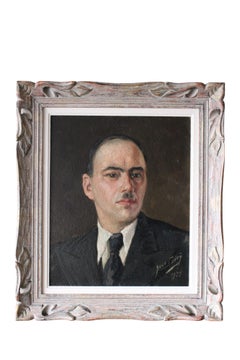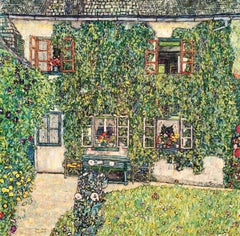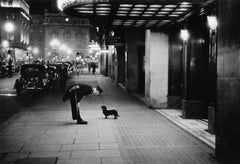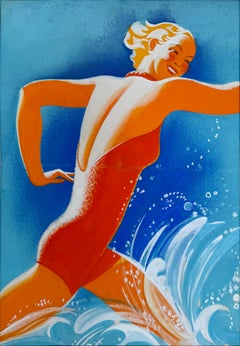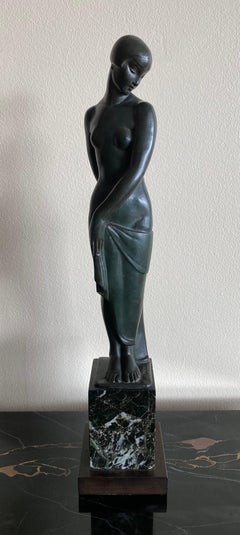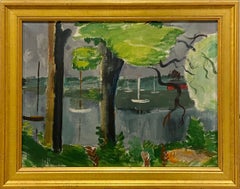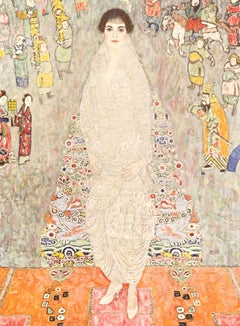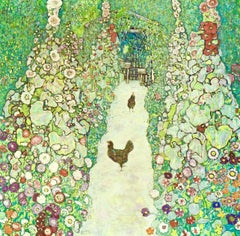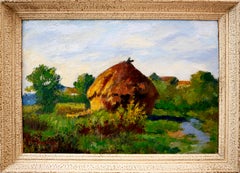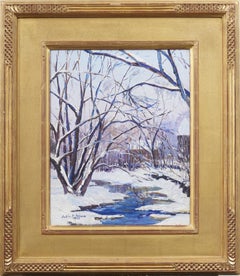1930s Art
to
1,102
3,395
1,216
889
525
334
Overall Width
to
Overall Height
to
7,526
21,108
157,625
234,017
1,957
2,285
4,860
6,407
5,767
12,989
19,258
25,468
18,069
13,714
5,363
2,448
485
366
226
128
111
100
72
12
12
5
2
2
3,518
2,375
313
3,830
1,722
1,617
1,136
1,099
712
454
440
433
365
356
318
290
285
272
255
225
220
213
193
1,987
1,524
1,333
1,184
853
261
105
89
83
61
1,713
1,147
3,329
2,664
Period: 1930s
A Serene 1930s Summer Harbor Scene of Saugatuck, Michigan by Francis Chapin
Located in Chicago, IL
A tranquil painting of a summer harbor in Saugatuck, Michigan by notable Chicago Modern artist, Francis Chapin. Dating circa 1935, oil on canvas, the painting depicts a colorful vie...
Category
American Modern 1930s Art
Materials
Canvas, Oil
Gustav Klimt, Portrait of Baroness Bachofen-Echt, 1931 (after)
By Gustav Klimt
Located in Southampton, NY
This exquisite heliogravure and collotype with metallic inks after Gustav Klimt (1862–1918), titled Bildnis Baronin Bachofen-Echt (Portrait of Baroness Bachofen-Echt), from the folio...
Category
Symbolist 1930s Art
Materials
Lithograph
$19,996 Sale Price
20% Off
Vintage Post-Impressionist French coastal landscape oil painting
Located in AIGNAN, FR
Vintage Post Impressionist framed oil painting on stretched canvas, signed in the bottom right, Abel Villard (1871-1969). A stunning, calm and moody depiction of a village boarderi...
Category
Post-Impressionist 1930s Art
Materials
Oil
$940 Sale Price
20% Off
Gustav Klimt, Farm Garden with Chickens, 1931 (after)
By Gustav Klimt
Located in Southampton, NY
This exquisite heliogravure and collotype with metallic inks after Gustav Klimt (1862–1918), titled Bauerngarten mit Huhnern (Farm Garden with Chickens), from the folio Gustav Klimt,...
Category
Symbolist 1930s Art
Materials
Lithograph
$19,996 Sale Price
20% Off
French School Impressionist Landscape Signed high texture Plein Air
Located in Zofingen, AG
➡️Vivid Landscape⬅️
➡️Plein air Impressionist Landscape⬅️
⏩It is signed H Sauvard.⏪
Possibly Henri Sauvard (1880-1973)
From Wikipedia:
Henri Sauvard was a French landscape painte...
Category
Impressionist 1930s Art
Materials
Gesso, Oil, Canvas, Stretcher Bars
$553 Sale Price
78% Off
Antique American Impressionist Landscape Signed Giltwood Framed Oil Painting
Located in Buffalo, NY
Antique American impressionist winter landscape oil painting. Oil on board. Framed. Signed. Measuring: 25 by 21 inches overall, and 16 by 13 painting alone. Handsomely framed in wi...
Category
Impressionist 1930s Art
Materials
Oil, Board
Vintage Pointalist Oil Painting by French artist Camille Lesne
Located in AIGNAN, FR
Unusual oil painting on wood board of a woman in a garden reading by French artist Camille Lesne, signed in the lower right corner and mounted in a vintage frame. Pointalism was a ...
Category
Pointillist 1930s Art
Materials
Oil
"Salomé" pochoir
Located in Henderson, NV
Medium: pochoir (after the gouache). This pochoir illustrates a scene from Oscar Wilde's "Salomé". It was printed in 1938 at the atelier Saudé of Paris and published by The Limited E...
Category
Fauvist 1930s Art
Materials
Lithograph, Stencil
Yuletide Spirit
Located in North Clarendon, VT
Whimsical Kate A. Williams arts and crafts impressionist painting circa 1930. Perfect for the holiday season. 20"x 16" oil on board, signed lower left. Frame is about 25x21.
Painter...
Category
American Impressionist 1930s Art
Materials
Oil
original etching
By John Sloan
Located in Henderson, NV
Medium: original etching. Executed by John Sloan to illustrate the Somerset Maugham classic "Of Human Bondage" and published in 1938 in a limited edition of 1500 by the Yale Universi...
Category
1930s Art
Materials
Etching
'Rain at Shinagawa, Ryoshimachi' — Showa-era Woodblock Print
By Kawase Hasui
Located in Myrtle Beach, SC
Kawase Hasui, 'Rain at Shinagawa, Ryoshimachi' from the series 'Selection of Views of the Tokaido', woodblock print, 1931. A very fine, atmospheric impression, with fresh colors; the...
Category
Showa 1930s Art
Materials
Woodcut
A Fine, Modern 1930s Academic Anatomical Figure Study (Seated Male Model, Torso)
Located in Chicago, IL
A Fine, 1930s Modern Academic Anatomical Figure Study Drawing of a Seated Male Nude Model (Torso) by Notable Chicago Artist, Harold Haydon (Am. 1909-1994). An exceptionally well exe...
Category
American Modern 1930s Art
Materials
Paper, Charcoal
'Lakeside Shower, Matsue' — Showa-era Woodblock Print
By Kawase Hasui
Located in Myrtle Beach, SC
Kawase Hasui, 'Chihan no Ame, Matsue' (Lakeside Shower, Matsue), color woodblock print, 1932. A fine, atmospheric impression, with fresh colors; the full sheet, from a postwar editio...
Category
Showa 1930s Art
Materials
Woodcut
Autumn Morning Spain oil on canvas painting mediterranean landscape
Located in Sitges, Barcelona
Author: Joan Gil i Gil (Barcelona, 1900 – 1984)
Title: Autumn Morning
Date: 1934
Technique: Oil on canvas
Dimensions: 81 × 100 cm (31.9 × 39.4 in)
Signature: Signed lower left: Joan ...
Category
Impressionist 1930s Art
Materials
Canvas, Oil
$1,506 Sale Price
20% Off
Charles PICART LE DOUX, Model on Green Background, Oil on Isorel, 1949
Located in Saint Amans des cots, FR
Oil on isorel panel by Charles PICART LE DOUX (1881-1959), France, 1949. Model on green background. With frame: 97.5x76.5 cm - 38.4x30.1 inches ; without frame: 81x60cm - 31.9x23.6 i...
Category
Post-Impressionist 1930s Art
Materials
Oil
Antique Italian Large Figurative Framed Oil Painting of a Reclining Nude Woman
Located in Douglas Manor, NY
5154 Antique Italian oil painting of a reclining nude woman
Framed
Image size 24x36"
Category
1930s Art
Materials
Oil
Zentsuji Temple in the Rain — from the series Collected Views of Japan II
By Kawase Hasui
Located in Myrtle Beach, SC
Kawase Hasui, 'Zentsuji Temple in the Rain' from the seres 'Collected Views of Japan II', color woodblock print, 1937. Signed Hasui in black ink, with the artist’s red seal Kawase, ...
Category
Showa 1930s Art
Materials
Woodcut
Lady In Blue Art Deco Female Painting
Located in Douglas Manor, NY
4066 Art Deco Lady in blue pastel painting
Set in a white frame
Category
1930s Art
Materials
Oil Pastel
$350 Sale Price
38% Off
Fall in the Mountain Valley
Located in North Clarendon, VT
Beautiful American School impressionist piece, unsigned, oil on board. Likely 1920-1940. Painted by a talented artist with wonderful composition and brushwork. 10" x 14" sight, 16.2...
Category
American Impressionist 1930s Art
Materials
Oil
"Pelham Bay" WPA American Scene Social Realism Modern NYC Subway Transportation
Located in New York, NY
"Pelham Bay" WPA American Scene Social Realism Modern NYC Subway Transportation
Daniel Ralph Celantano (1902-1980)
"Pelham Bay"
12 1/4 x 16 inches
Oil on canvas
Signed lower cente...
Category
American Realist 1930s Art
Materials
Oil, Canvas
Gustav Klimt, Portrait of Friederike Maria Beer, 1931 (after)
By Gustav Klimt
Located in Southampton, NY
This exquisite heliogravure and collotype with metallic inks after Gustav Klimt (1862–1918), titled Bildnis Friederike Maria Beer (Portrait of Friederike Maria Beer), from the folio ...
Category
Symbolist 1930s Art
Materials
Lithograph
$19,996 Sale Price
20% Off
A Fine 1930s, Modern Academic Figure Study Drawing, Seated Male Model, Young Man
Located in Chicago, IL
A Fine 1930s Modern Academic Figure Study Drawing, Seated Male Nude Model (Back) by Notable Chicago Artist, Harold Haydon (Am. 1909-1994). An exceptionally well executed early 1930s...
Category
American Modern 1930s Art
Materials
Charcoal, Paper
A Fine 1930s, Modern Academic Figure Study Drawing, Standing Male Nude (Back)
Located in Chicago, IL
A Fine 1930s, Modern Academic Figure Study Drawing of a Standing Male Nude Model (Back) by Notable Chicago Artist, Harold Haydon (Am. 1909-1994). An exceptionally well executed, ear...
Category
American Modern 1930s Art
Materials
Paper, Charcoal
Irving Guyer, Roll Them Bones, Depression-era African-American men at craps
By Irving Guyer
Located in New York, NY
An American Depression-Era subject of African-American men playing craps by Irving Guyer.. (Craps is a game of chance that required neither skill nor strategy. The object is to predi...
Category
Ashcan School 1930s Art
Materials
Etching
American School Self Portrait, Circle of N C Wyeth, Bernard Stafford Good 1937
Located in Baltimore, MD
This is a well done self portrait of the listed American artist Bernard Stafford Good. Painted in 1937, it is a fine example of American illustration art produced by the Brandywine School of Southeastern Pennsylvania and Delaware of the period. It also relates to Norman Rockwell and his illustrative style of the early twentieth century. The portrait is oil on c...
Category
Post-Impressionist 1930s Art
Materials
Oil
Wassily Kandinsky, Komposition, from XXe siecle, 1939
Located in Southampton, NY
This exquisite woodcut by Wassily Kandinsky (1866–1944), titled Komposition (Composition), from the album XXe siecle, Chroniques du jour, 13 rue Valette (5e), Directeur G. di San Laz...
Category
Modern 1930s Art
Materials
Woodcut
$7,196 Sale Price
20% Off
1932 Folk Art Needlepoint Map Midwest Midwestern states
Located in Wilton Manors, FL
Beautiful antique 1932 needlepoint map of Midwestern states. Framed measurement: 23 x 36 inches.
Category
Folk Art 1930s Art
Materials
Yarn
Nude, Oil on Canvas by B.Robert, Ca. 1930
Located in Saint Amans des cots, FR
Oil on Canvas by B. Robert, France, circa 1930. This exquisite oil painting by B. Robert, created in France around 1930, captures the serene beauty of a young nude woman reclining. T...
Category
Art Deco 1930s Art
Materials
Canvas, Oil
A Very Finely Drawn 1930s Figure Study of a Young Male Nude- Shoulder & Arm
Located in Chicago, IL
A Very Finely Drawn 1930s Figure Study of a Young Male Nude Model (Shoulder, Arm & Torso) by Notable Chicago Modern Artist, Harold Haydon (Am. 1909-1994). An early charcoal drawing...
Category
American Modern 1930s Art
Materials
Paper, Charcoal
Litografía original VI
By Joan Miró
Located in OPOLE, PL
Joan Miro (1893-1983) - Litografía original VI
Lithograph from 1972.
Dimensions of work: 32 x 24.5 cm.
Publisher: Maeght Éditeur, Paris.
Printed by: Fernand Mourlot, Paris.
The ...
Category
Surrealist 1930s Art
Materials
Lithograph
$564 Sale Price
20% Off
“Danseuse Aux Cymbales”
Located in Southampton, NY
ABOUT
Beautiful and impressive Art Deco statue of a dancing woman with cymbals. Circa 1935.
Original title "Danseuse Aux Cymbales".
Signed “Fayral” on base which is the pseudonym of...
Category
Art Deco 1930s Art
Materials
Metal
A Fine, Modern 1930s Academic Anatomical Figure Study (Seated Male, Torso)
Located in Chicago, IL
A Fine, 1930s Modern Academic Anatomical Figure Study Drawing of a Seated Male Nude Model (Torso) by Notable Chicago Artist, Harold Haydon (Am. 1909-1994). An exceptionally well exe...
Category
American Modern 1930s Art
Materials
Charcoal, Paper
Vintage roses oil painting on wood board by French artist Ana Bono-Dugelay
Located in AIGNAN, FR
Vintage French roses still life oil painting on wood board, signed in the bottom right, Ana Bono-Dugelay. This striking old wood board is inscribed and dated on the back 1939. A si...
Category
French School 1930s Art
Materials
Oil
Gustav Klimt, Sunflowers, 1931 (after)
By Gustav Klimt
Located in Southampton, NY
This exquisite heliogravure and collotype with metallic inks after Gustav Klimt (1862–1918), titled Sonnenblumen (Sunflowers), from the folio Gustav Klimt, Eine Nachlese (Gustav Klim...
Category
Symbolist 1930s Art
Materials
Lithograph
$19,996 Sale Price
20% Off
Art Deco Portrait of a Woman
Located in Wilton Manors, FL
Laura M. GREENWOOD (1897-1951).
Portrait of Woman in Winter Coat
Oil on canvas, 18 x 24.5 inches.
Signed lower left. Excellent condition. Would beneifit from a cleaning. Origina...
Category
Art Deco 1930s Art
Materials
Oil
'Poppy' — Art Deco Pochoir from the acclaimed portfolio 'RELAIS'
Located in Myrtle Beach, SC
Edouard Benedictus, 'Poppy' from the portfolio 'Relais', plate 14, color pochoir, 1930. Signed in the matrix, in the center bottom margin. A superb, richly-inked impression, with fresh, vibrant colors, including metallic gold and silver inks, on heavy, cream wove paper; the full sheet with margins (1 3/8 inches), in excellent condition. Published by Éditions Vincent, Fréal et Cie, Paris. The pochoir production is by Jean Saudé, the French printmaker known for his mastery of the technique and the author of the first how-to book on the pochoir process. Matted to museum standards, unframed.
Image size 14 3/8 x 11 inches (365 x 279 mm); sheet size 17 1/4 x 13 7/8 inches (438 x 352 mm).
Impressions of this work are held in the following museum collections: Cooper-Hewitt National Design Museum Library (Smithsonian), Metropolitan Museum of Art, Minneapolis Institute of Art, New York Public Library, Toledo Museum of Art, Victoria and Albert Museum (London), Virginia Museum of Fine Arts.
ABOUT THIS WORK
The Pochoir process is a refined stencil-based technique employed to create multiples or to add color to prints produced in other mediums. Characterized by its crisp lines and rich color, the print-making process was most popular from the late 19th century through the 1930s, with its center of activity in Paris. The pochoir process began with the analysis of an image’s composition, including color tones and densities. The numerous stencils (made of aluminum, copper, or zinc) necessary to create a complete image were then designed and hand-cut by the 'découpeur.' The 'coloristes' applied watercolor or gouache pigments through the stencils, skillfully employing a variety of different brushes and methods of paint application to achieve the desired depth of color and textural and tonal nuance. The pochoir process, by virtue of its handcrafted methodology, resulted in the finished work producing the effect of an original painting, and in fact, each print was unique.
ABOUT THE ARTIST
Edouard Benedictus (1878 -1930), artist, designer, composer, and chemist, was born and died in Paris. A highly-regarded designer and art critic of the Art Nouveau era, Benedictus gained renown as a colorist and creator of Art Deco-inspired geometric and floral motifs. His work had a significant influence on international fashions in clothing, home furnishings, graphic design, and decorative objects of the period, earning him commissions from leading European design firms. In 1925 he was invited to represent Art Deco textile design...
Category
Art Nouveau 1930s Art
Materials
Stencil
Antique American Large Signed Abstract Expressionist Modern Art Oil Painting
Located in Buffalo, NY
Antique American abstract expressionist painting. Oil on canvas. Framed. Signed. Measuring: 37 by 43 inches overall, and 36 by 42 painting alone. In excellent original condition. ...
Category
Abstract Expressionist 1930s Art
Materials
Canvas, Oil
Cirque
By Marc Chagall
Located in OPOLE, PL
Marc Chagall (1887-1985) - Cirque
Lithograph from 1967.
The edition of 250 on Arches paper.
Dimensions of work: 42 x 32.5 cm.
Publisher: Tériade, Paris.
Reference: Mourlot 487, ...
Category
Symbolist 1930s Art
Materials
Lithograph
$1,527
La Grande Corrida
Located in OPOLE, PL
Pablo Picasso (1881-1973) - La Grande Corrida
Etching from 1934.
The edition of 50 on Montval paper.
Dimensions of work: 56.8 x 77 cm.
Reference: Bloch 1330; Baer 433.
The work ...
Category
Modern 1930s Art
Materials
Etching
Femme Torero I
Located in OPOLE, PL
Pablo Picasso (1881-1973) - Femme Torero I
Etching from 1934.
The edition of 50 on Montval paper.
Dimensions of work: 57 x 77 cm.
Reference: Bloch 1329; Baer 425.
The work is in...
Category
Modern 1930s Art
Materials
Etching
Signed Antique American Impressionist Framed Landscape Oil Painting
Located in Buffalo, NY
Charles Sutton, “April Afternoon,” Oil on Board, Framed Landscape Painting
Warmly toned impressionist oil painting by Charles Sutton, titled April Afternoon. The work captures a tra...
Category
Impressionist 1930s Art
Materials
Canvas, Oil
Gustav Klimt, The Friends, 1931 (after)
By Gustav Klimt
Located in Southampton, NY
This exquisite heliogravure and collotype with metallic inks after Gustav Klimt (1862–1918), titled Die Freundinnen (The Friends), from the folio Gustav Klimt, Eine Nachlese (Gustav ...
Category
Symbolist 1930s Art
Materials
Lithograph
$19,996 Sale Price
20% Off
Rockport Landscape
Located in Wilton Manors, FL
Beautiful 1931 painting by American artist, Giovanni Martino (1908-1997). Oil on canvas measures 25 x 30 inches. Measures 35 x 39 inches framed. The scene depicts what is definitively the Rockport, Mass. fishing pier. Excellent condition with a few very minor areas of paint flaking. The darker areas in the sky is a result of unpainted areas. The canvas is sized with glue but not primed white: observable areas of natural linen color results. Signed wet into wet and dated lower left. No restoration or overpaint.
Giovanni Martino, National Academy of Design* member, was born on May 1, 1908 in Philadelphia PA where all seven brothers and one sister, Filomina, Frank, Antonio, Albert, Ernest, Giovanni, Edmond, and William became painters. They were under the tutelage of their eldest brother, Frank, who in the late 1920s, founded the first commercial art* studio, Martino Studios, at 27 South 18th Street.
Besides studying with his two eldest brothers, Giovanni also studied with Albert Jean Adolph at La France Institute, The Pennsylvania Academy of the Fine Arts*, The Graphic Sketch Club, and Spring Garden Institute in Philadelphia. In his mid teens he accompanied his two eldest brothers to New Hope searching for subjects to paint. In the 1930s, he also started to paint in Manayunk, a hilly mill town along the Schuylkill River...
Category
American Impressionist 1930s Art
Materials
Oil
$1,440 Sale Price
20% Off
1930s Mexican City Scene by Famed Chicago Artist Francis Chapin, Guaymas, Mexico
Located in Chicago, IL
A charming, vibrant, early Mexican city street scene by famed Chicago Modern artist Francis Chapin (Am. 1899-1965). Depicting a quiet street in the historic, picturesque city of Gua...
Category
American Modern 1930s Art
Materials
Oil, Masonite
Figure, Verve: Revue Artistique et Littéraire
Located in Southampton, NY
Lithograph on vélin des Papeteries du Marais paper. Paper Size: 14 x 10.25 inches. Inscription: Unsigned and unnumbered, as issued. Notes: From the album, Verve: Revue Artistique et ...
Category
Cubist 1930s Art
Materials
Lithograph
$716 Sale Price
20% Off
Gentleman with a Pipe - 1930's French Post Impressionist Portrait Oil Painting
Located in Sevenoaks, GB
A striking 1930's French post-impressionist oil on board portrait of a gentleman smoking a pipe by Antonin Guéton.
Excellent quality and condition post-impressionist portrait. Sign...
Category
Post-Impressionist 1930s Art
Materials
Oil, Board
Antique Italian Large Figurative Framed Oil Painting of a Reclining Nude Woman
Located in Douglas Manor, NY
5154 Antique Italian oil painting of a reclining nude woman
Framed
Image size 24x36"
Category
1930s Art
Materials
Oil
Teeny - Original linocut, 1938 - Referenced in Duthuit #723
Located in Paris, IDF
Henri MATISSE
Teeny
Original linocut
Printed signature in the plate
On light wove paper 31 x 24 cm (c. 12.5 x 10 in)
REFRENCES : Catalogue raisonne Duthuit #723
From the unsigned, ...
Category
Modern 1930s Art
Materials
Linocut
"Cheetah Who Shops" by B C Parade
Located in London, GB
"Cheetah Who Shops" by B C Parade
American silent film actress Phyllis Gordon (1889 - 1964) window-shopping in Earls Court, London with her four-yea...
Category
Modern 1930s Art
Materials
Black and White
Cinésias et Myrrhine (Bloch 267-272; Cramer 24), Lysistrata, Pablo Picasso
Located in Southampton, NY
Etching on vélin de Rives BFK paper. Paper Size: 11.5 x 9 inches. Inscription: Unsigned and unnumbered, as issued. Notes: From the album, Lysistrata, 1934. Published by The Limited E...
Category
Cubist 1930s Art
Materials
Etching
$11,596 Sale Price
20% Off
City at Night (Cityscape)
By Abram Tromka
Located in Wilton Manors, FL
Abram Tromka (1895-1964)
City at Night, ca. 1940.
Oil on canvas, 16 x 20 inches; 20 x 24 inches in antique oak frame. Signed lower right.
Frame is of the period, but probably not ...
Category
American Modern 1930s Art
Materials
Canvas, Oil
Strike Breakers — social realism, Great Depression
Located in Myrtle Beach, SC
Daniel Ralph Celentano, Untitled (Strike Breakers) pencil, c. 1934. Signed, lower right. A fine, social-realist drawing, on cream wove paper, with margins (1 1/2 to 2 1/2 inches), in...
Category
American Realist 1930s Art
Materials
Pencil
Vintage American Impressionist Sunlit Farm Valley Signed Landscape Oil Painting
Located in Buffalo, NY
Vintage American impressionist farm landscape oil painting by Stephen Voorhies (Born 1898). Oil on canvas. Framed. Measuring: 27 by 31 inches overall, and 20 by 24 painting alone. I...
Category
Impressionist 1930s Art
Materials
Canvas, Oil
The Endeavour.
Located in Storrs, CT
The Endeavour. c.1935. Pencil and watercolor on watercolor board. 14 3/8 x 20 7/8. Signed in pencil, lower right; titled in pencil, verso. Housed in a subtle 23 1/2 x 36-inch light ...
Category
Modern 1930s Art
Materials
Watercolor, Pencil
$2,000 Sale Price
50% Off
Fancy Department Store Satirical Cartoon
Located in Wilton Manors, FL
Barbara Shermund (1899-1978). Fancy Department Store Satirical Cartoon, ca. 1930's. Ink, watercolor and gouache on heavy illustration paper, panel measures 19 x 15 inches. Signed lower right. Very good condition. Unframed.
Provenance: Ethel Maud Mott Herman, artist (1883-1984), West Orange NJ.
For two decades, she drew almost 600 cartoons for The New Yorker with female characters that commented on life with wit, intelligence and irony.
In the mid-1920s, Harold Ross, the founder of a new magazine called The New Yorker, was looking for cartoonists who could create sardonic, highbrow illustrations accompanied by witty captions that would function as social critiques.
He found that talent in Barbara Shermund.
For about two decades, until the 1940s, Shermund helped Ross and his first art editor, Rea Irvin, realize their vision by contributing almost 600 cartoons and sassy captions with a fresh, feminist voice.
Her cartoons commented on life with wit, intelligence and irony, using female characters who critiqued the patriarchy and celebrated speakeasies, cafes, spunky women and leisure. They spoke directly to flapper women of the era who defied convention with a new sense of political, social and economic independence.
“Shermund’s women spoke their minds about sex, marriage and society; smoked cigarettes and drank; and poked fun at everything in an era when it was not common to see young women doing so,” Caitlin A. McGurk wrote in 2020 for the Art Students League.
In one Shermund cartoon, published in The New Yorker in 1928, two forlorn women sit and chat on couches. “Yeah,” one says, “I guess the best thing to do is to just get married and forget about love.”
“While for many, the idea of a New Yorker cartoon conjures a highbrow, dry non sequitur — often more alienating than familiar — Shermund’s cartoons are the antithesis,” wrote McGurk, who is an associate curator and assistant professor at Ohio State University’s Billy Ireland Cartoon Library & Museum. “They are about human nature, relationships, youth and age.” (McGurk is writing a book about Shermund.
And yet by the 1940s and ’50s, as America’s postwar focus shifted to domestic life, Shermund’s feminist voice and cool critique of society fell out of vogue. Her last cartoon appeared in The New Yorker in 1944, and much of her life and career after that remains unclear. No major newspaper wrote about her death in 1978 — The New York Times was on strike then, along with The Daily News and The New York Post — and her ashes sat in a New Jersey funeral home...
Category
Realist 1930s Art
Materials
Gouache, Ink
$1,875 Sale Price
25% Off
'Negro' — California WPA Social Realism – Slavery
Located in Myrtle Beach, SC
Nicholas Panesis, 'Negro', 1934, color lithograph, edition 18. Signed, dated, titled, and numbered 8/28 in pencil. Initialed in the stone, lower right. A fine impression, with fresh colors, on buff wove paper, with margins (1 1/8 to 2 3/8 inches). Minor glue staining at the extreme sheet edges verso, where previously taped (not visible recto), otherwise in excellent condition. Matted to museum standards, unframed.
Image size 10 5/8 x 8 1/2 inches; (270 x 216 mm); sheet size 14 13/16 x 10 15/16 inches (376 x 278 mm).
Created for the California Works Progress Administration, Federal Art Project (WPA). Scarce.
Impressions of this work are held in the public collections of La Salle University Art Museum (Philadelphia), U.S. General Services Administration, and Weisman Art Museum (University of Minnesota).
ABOUT THE ARTIST
Born in Massachusetts, Nicholas Panesis (1913-1967) studied art at Syracuse University, NY, and went on to teach ceramics at Alfred University, NY.
Panesis moved to San Francisco in the early 1930s shortly before settling in Los Angeles, where he worked for different animation studios...
Category
American Realist 1930s Art
Materials
Lithograph
Farm in Berlin Heights, Ohio, Vibrant Field Landscape
Located in Beachwood, OH
August Frederick Biehle (1885-1979)
Farm in Berlin Heights, c. 1930
Oil on masonite
Signed lower right
22 x 30 inches
27.75 x 36 inches, framed
A versatile painter who worked in a v...
Category
American Modern 1930s Art
Materials
Oil
'Portrait of the Nephew of the Artist' by René Seyssaud, French Oil Painting
By René Seyssaud
Located in London, GB
'Portrait of the Nephew of the Artist', oil on canvas, by René Seyssaud (circa 1930s). Known for his use of vivid colours in his landscapes and depictions of workers in their fields,...
Category
1930s Art
Materials
Canvas, Oil
Large Landscape oil painting of a picnic by the lake in Autumn
By Lucien Jonas
Located in AIGNAN, FR
Vintage Post Impressionist framed oil painting on board attributed to French artist Lucian Hector Jonas (1880-1947). This is a stunning and quite unusual, beautifully framed oil pai...
Category
French School 1930s Art
Materials
Oil
'Abstract, Turquoise and Gray', Paris, Picasso, Andre L'Hote, Guernica, Benezit
By Dora Maar
Located in Santa Cruz, CA
'Abstract, Turquoise and Gray' by Dora Maar.
Paris, Picasso, Andre L'Hote, Guernica, Benezit
-----
Signed verso with artist monogram 'DM' for Dora Maar (Argentine-French, 1907-1997)...
Category
Abstract 1930s Art
Materials
Oil, Canvas
$7,500 Sale Price
21% Off
